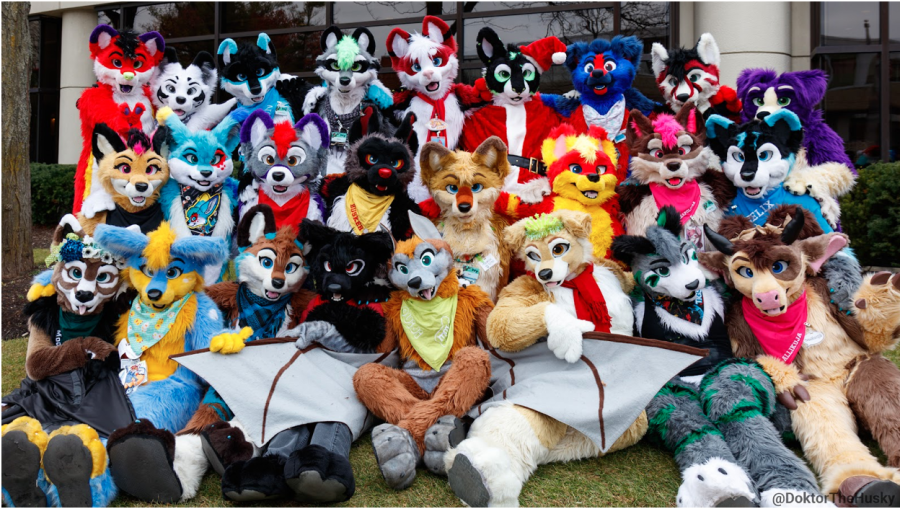The Truth Behind Furries and the Furry Fandom
April 5, 2023
The Furry Fandom is a widely known community, but often for the wrong reasons. Furries are associated with being weird, gross, highly sexual, and awkward. But just because these are the words typically associated with furries, that doesn’t mean they are true. If there is one word to describe furries, it is the word “Misunderstood”.
The furry fandom, boiled down to its core, is the enjoyment and liking of anthropomorphic animals. These are animals with human-like characteristics and features, such as speech and standing on two legs, just to name two. Sound familiar? This is because these human-like animals are everywhere. Movies, commercials, tv shows, games, the list goes on. The fandom itself was founded on this rather basic principle of animal people.
Anthropomorphism has been around for thousands of years, dating back an estimated 40,000 years. When it comes to furries, however, it is widely accepted that the furry fandom began to form in 1980 at a science fiction convention in California with an art panel that featured anthropomorphic animals. This sparked discussion groups at these science fiction conventions and they began to grow. By 1983, the name “Furry Fandom” was being used as the name for this growing group of people. The first only furry convention to ever be hosted was ConFurence 0 in Costa Mesa, CA. in 1989
Ever since the fandom’s beginning, there has been misinformation, bad publicity and negative feelings toward the community. There is a wide variety of these misconceptions, and some are very detrimental to the image of furries. In regards to the misconceptions surrounding the community, furry YouTuber and streamer Rali said, “There are a lot of misconceptions about the fandom being what it is. People think ‘oh they all want to just be animals and be really creepy towards younger individuals’ or something. No. No one [does]. At least no one who’s not ostracized or kicked out of the fandom is doing that.”
Even though these misunderstandings may not represent the large majority of the community, they do still represent small pockets of the community. These people may consider themselves furries, but by the community at large, they are frowned upon. “There sadly is, I believe, hidden groups that share that mutual interest. I do not condone witch-hunting towards these groups as they are completely out of the subject here; they’re not part of the fandom, nor the communities. They’re an excluded, different group,” said Dræghy, a member of the community from France.
But these small pockets of people who call themselves furries are the main reason for many of the largest myths about the fandom. Even though the community at large tries to downplay the significance of these pockets of people, the media focuses on them and what most people focus on and imagine when they think about furries. “There is sensitive subjects like pedophilia and zoophilia which are absolutely horrendous to everybody, the media sadly pushed this forward, and gave a very bad light, as the fandom is very much so against it compared to what everybody says.” said Dræghy.
Some of the other misunderstandings aren’t to the scale of things such as pedophilia and zoophilia, yet they still tarnish and affect the image of the furry fandom and what it is truly about. One of the most recent of these misunderstandings is that schools are installing litter boxes for students who identify as cats. This rumor is simply untrue, and was started as a way to poke fun at furries back in the early 2000’s. This has since resurfaced as a right-wing anti-trans myth spread during the 2022 midterm elections. Even if it was true that schools were adding litter boxes for students, those students allegedly identifying as cats are not under the umbrella of the furry fandom. Rather, they typically fall under the category of therians and otherkin, not necessarily the furry community.
Therians and otherkin are two separate subcultures from each other, and from the furry fandom as well. The three groups are all unique and have their differences, but sometimes overlap. The core premise of the furry fandom is, again, the liking of anthropomorphic animals as a hobby. The differences between Therians and Otherkin are somewhat blurred, though both share the core ideas that they are either not-fully human or not human at all. These two groups are also based on spiritual bonds rather than just being a hobby. So even though these three groups are all separate, they do share some similarities and some people identify with and participate in both. According to a study at Anthrocon 2018 by FurScience.com, 7% of those who answered the survey identified as therian, and 5% as otherkin. These groups only made up 12% of furries who attended Anthrocon that year, a rather low percentage.
Some of the other widespread misconceptions surrounding the fandom include smaller things, such as the idea that every furry owns a fursuit. Fursuiters are in the minority at conventions, even at large conventions such as AnthroCon 2018 where only 45.8% had partial or full fursuits, according to furscience.com. This figure is likely biased, and online surveys tend to put the percentage more around 15%-25%. This is likely due to the fact that fursuits are expensive, and so if someone has the money for a fursuit, they are more likely to have enough money for travel costs to these in-person events.
So with some of the main misconceptions and myths touched on, what does the fandom really mean to those in it? The answers to that question vary from person to person. Kiara, a furry from Mississippi, said, “For me honestly it’s just a really fun hobby, and a really cool way to show your creative side.”
Furry YouTuber Rali said, “It’s all a matter of who you associate with, or what you make of the fandom. But for me, it’s always been a safe space and always been an outlet for creativity. I mean, Rali came from my head. It’s just been so rewarding to see, ‘oh, I made that. This thing represents me, it’s really cute and I like it.”
For Dræghy, the furry community means, “…Quite a lot, there’s so much to say and to describe, but it’s more personal and emotional than anybody would think, skipping the artistic space these communities give.” Dræghy responded.
Overall, the furry fandom could be described in many different ways. But it really comes down to what you make of it, whether a furry or not. The fandom is just like any other community, and should be treated as such. Sure, there may be some bad apples, but there’s bad apples just about everywhere you look in the world. The furry fandom may be misunderstood, but if you take the time to learn about it, and you learn the truth of the community, you discover the real best word to describe the fandom: Normal.




Stella • Mar 14, 2024 at 11:29 am
great article 🙂
Oktena Dovahkiin • Jul 28, 2023 at 7:53 am
As a scaly (a furry, but with reptiles and dragons) and a warrior for peace, I will absolutely force this article upon haters to read it (if they know how to read). As the dovahkiin would say, “Ziistmaas drem kos voth hi” or May peace be with you
Nathaniel • May 19, 2023 at 12:31 pm
‘The Truth Behind Furries and the Furry Fandom’, is an exquisite piece of art that entertains a thought experiment truly highlighting how our universe functions and includes information pertaining to what it is to be human in this modern society. This article will surely go down with the writings and teachings of the many great philosophers and scientists throughout history.
Clifford Martella • Apr 23, 2023 at 3:49 pm
Thank you for presenting a fact filled unbiased article on furries. It is truly important more people do their research instead of immediately assuming. The litter box rumor has been debunked and the outlets that spread it have retracted their statements and apologized. I believe in a less judgemental future, and I believe in holding the bad individuals accountable. We want a better future for everyone. For many, the furry community is an escape from daily challenges and issues socializing, but with the suit and head on you can be a character without those issues. It brings out the best of someone. I hope this article can change the mind of some people.
Anon • Jul 21, 2023 at 5:30 pm
bro this is incredibly biased wdym
Not tommy • Apr 11, 2023 at 11:06 am
What do you think KM’s fursona is
Jay • Apr 6, 2023 at 6:25 pm
Great article! Really well written and helps to accurately debunk the many misconceptions about the furry fandom and it’s members!
Knox Orchard • Apr 6, 2023 at 8:53 am
This changed my opinion on furries
kim kardashian • Apr 6, 2023 at 8:49 am
i found this article to be exceptional but due to the barbaric nature of the writer i must give it a 7/10
Fraser Zahniser • Apr 6, 2023 at 8:45 am
truly a life changing piece of literature
Evan Kel III • Apr 5, 2023 at 10:57 pm
This article has truly opened my eyes. Hayden has captured lightning in a bottle and made electricity all by himself. This is the type of shit to make me change my mind and it did. I loved this so god damn much. My brain cells are firing differently now in favor of furries. <3
Hubert Pumpernickel’s Mom • Apr 5, 2023 at 12:03 pm
very nice!!!!!! i don’t suport fury but i liked the aticle!!! -Hubert Pumpernickle
sebastian • Apr 5, 2023 at 11:54 am
It was excellently written and I really enjoyed reading it